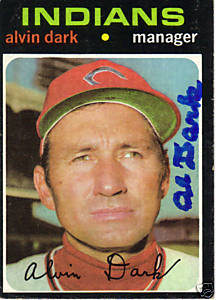 (Shouting) “Live music is better; bumper stickers should be issued.” – "Union Man", from Hawks and Doves, Neil Young, 1980.
(Shouting) “Live music is better; bumper stickers should be issued.” – "Union Man", from Hawks and Doves, Neil Young, 1980.
You may know - or recall - that on one glorious afternoon in 1954, the Cleveland Indians drew 80,000+ fans to a late summer doubleheader vs. the New York Yankees. Since a constant theme throughout this 2013 season has been lagging attendance, today we are going to shine the light of day on perhaps the darkest era in Cleveland baseball fandom.
We could focus on the Indians’ season of 1963. They did finish with a respectable 79-83 record that year. Apparently the disappointment of becoming an also-ran after contending as recently as 1959 had taken its toll. In ‘63, Cleveland hosted the All-Star game, and only a little more than half the stadium was filled for that event!
There was the Tribe of 1983-1985. The weak turnout during this period puzzles me, since one of my reasons (excuses) for the light attendance in 2013 is the lack of hitting. Fan favorites Grady, Victor and Pronk are gone, and while this team can pitch, “chicks (and kids) dig the long ball” (and offense in general). The mid-80s squads lost a lot of games, but boasted lineups that could score. Andre Thornton, Julio Franco, Mike Hargrove, Brett Butler, Joe Carter, Pat Tabler, and Brook Jacoby dotted the rosters of those teams.
Then there were the Cleveland Indians of 1971. The season attendance of 591,361 – an average of 7,300 per game- was among the team’s lowest since WWII. However, my understanding is that in some of those ‘bad-old-years’, the announced attendance was often higher than actual. So, who is to say 1971 didn’t ‘beat’ 1963 in the ‘how low can you go’ derby?
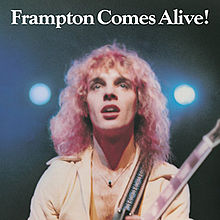 Let’s continue to celebrate the joys of live performances by giving a nod to some of tasty live-recorded Classic Rock tunes. This time, they’ll all be pulled from the mid-to-late ‘70s (yes, it was my formative era). Because it’ll be fun- and this is Cleveland after all, where we like this kind of stuff.
Let’s continue to celebrate the joys of live performances by giving a nod to some of tasty live-recorded Classic Rock tunes. This time, they’ll all be pulled from the mid-to-late ‘70s (yes, it was my formative era). Because it’ll be fun- and this is Cleveland after all, where we like this kind of stuff.
For instance, how about Peter Frampton’s “Do You Feel Like We Do”, from “Frampton Comes Alive” (1976)? Nobody doesn’t love them some Frampton, no? The full 14:16 version is fun, but the shortened 7:19 live single is just fine as well. After a background role with Wishbone Ash, Frampton toured the U.S. in support of the J.Geils Band and ZZ Top. This song became his finale, as it continues to be today. The talk box is featured- this is an effects pedal with a tube for the mouth that a guitarist can use to vocalize sounds. (Some non-Frampton songs employing this effect include “Rocky Mountain Way” by Cleveland’s Joe Walsh, “Tell Me Something Good” by Chaka Khan and Rufus, and “Sweet Emotion” by Aerosmith.)
Of course, to my nine year old eyes, that ’71 Indians roster was terrific. I was jumping with both feet into my hero-worshipping era. And really, what more could a fan ask for than the typical lineup the Tribe trotted out onto the field?
The manager- to start the season, anyway - was Alvin Dark (top photo).
1B Chris Chambliss. The flashy Ken Harrelson (self-glossed, "Hawk") was expected to continue to man the position, but he was injured, and retired to play professional golf during the 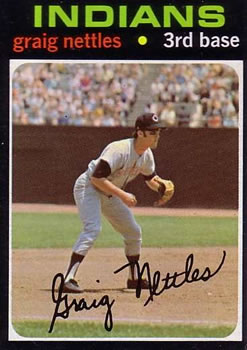 season. Tony Horton’s unfortunate exit from the game (and the public eye) had occurred in 1970. Chambliss, chosen #1 overall by the Tribe out of UCLA in ’70, won the 1971 A.L. Rookie of the Year award.
season. Tony Horton’s unfortunate exit from the game (and the public eye) had occurred in 1970. Chambliss, chosen #1 overall by the Tribe out of UCLA in ’70, won the 1971 A.L. Rookie of the Year award.
2B Eddie Leon. A fine infielder who played with hustle. A slap hitter who’d led the league in sacrifices in 1970.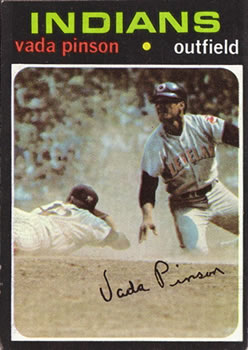
SS Jack Heidemann. Had been the youngest player in the league in 1970, succeeding Larry Brown at the position. Lost his job to Frank Duffy in 1972.
3B Graig Nettles. The future star had been acquired from the Minnesota Twins by the Tribe in 1969 (in the Luis Tiant trade). He flashed promise both with the glove and at the plate. Unfortunately, he and Chambliss would star for the champion Yankees within a few seasons.
LF Ted Uhlaender. Acquired in the same trade that netted the Indians Graig Nettles.
CF Vada Pinson. A solid veteran; played with Frank Robinson in high school and with the Cincinnati Reds in the ‘50s and ‘60s. (Pinson is an interesting study. A four-time All Star, he was constantly overshadowed by perhaps the most underrated superstar ever, in Robinson.)
RF Roy Foster. Foster’s cup-o-coffee major league career was solely with the Indians.
C Ray Fosse. Pete Rose bowled him over as Fosse waited at home plate for the throw from Royals CF Amos Otis in the 1970 All Star game. His shoulder was forever damaged, but Fosse still had a solid career. He won a Gold Glove for the second straight season in 1971.
“Maybe I’m Amazed”, “Wings Over America” (1976) by Paul McCartney and Wings. LOOOOVE this. Pretty ra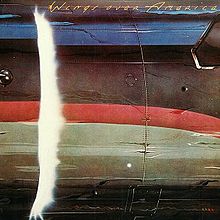 re for one of my all-time favorite recordings to be an easy listening staple on FM radio. You do hear the original studio version from time to time, and that is greatly diminished by this very nice live cut. (Two quick thoughts on McCartney. One, he had a funny comment in recent years about his age. He said when he was in Wings, they encountered young fans who’d never heard of the Beatles. Now, many have never heard of Wings. The other thought: the various Beatles admitted dropping a lot of acid. They have said they once took LSD every day for three years. That’s, like, over 1,000 days in a row. Oh. My. Gosh. That explains a lot. Not everything, but a lot.)
re for one of my all-time favorite recordings to be an easy listening staple on FM radio. You do hear the original studio version from time to time, and that is greatly diminished by this very nice live cut. (Two quick thoughts on McCartney. One, he had a funny comment in recent years about his age. He said when he was in Wings, they encountered young fans who’d never heard of the Beatles. Now, many have never heard of Wings. The other thought: the various Beatles admitted dropping a lot of acid. They have said they once took LSD every day for three years. That’s, like, over 1,000 days in a row. Oh. My. Gosh. That explains a lot. Not everything, but a lot.)
The Detroit Tigers were kind of my favorite non- Indians team, circa 1971. They had won the World Series in 1968, and still boasted a veteran, talent-laden lineup. ’71 was Billy Martin’s first season as their skipper, and he would guide them to the playoffs in 1972. I just looked up their ’71 lineup, after trying to recite it by memory. I only missed a couple.
1B (and one-time Tribe farmhand) Norm Cash. 2B Dick McAuliffe, a dude with a very strange, open batting stance. SS Eddie Brinkman. 3B Aurelio Rodriguez. LF Willlie Horton. CF Mickey Stanley. RF Al Kaline. C Bill Freehan.
“Rock and Roll All Nite”, “Alive!” by Kiss. Not the best song, even on this 1975 album. Other tunes, like “Strutter" and “Rock Bottom”, are better. In my humble opinion. On “Rock and Roll All Nite”, though, you get to do the rapid air-drums a few times. SWEET. But any enjoyment of Kiss is a guilty pleasure. Sorry, it just is. Nothing wrong with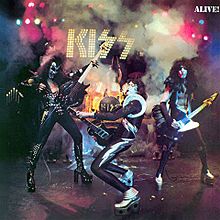 that! (By the way, I just learned that some early, notable Kiss recordings were done at shows at Music Hall in Cleveland, in 1975.)
that! (By the way, I just learned that some early, notable Kiss recordings were done at shows at Music Hall in Cleveland, in 1975.)
Unfortunately, the 1971 Cleveland Indians had a really tough season. They did attract a turnout of 40,000+ on Opening Day, and 50,000+ for a Sunday double header. However, they couldn’t even clear the 3000 mark in attendance nine separate times. Envision a stadium double the size of Progressive Field, holding less than half the number of patrons seen on 2013’s scarcest nights. Of course, the '71 team would finish at 60-102, 43 games out of first place.
Let’s take a peek at the final game of the Tribe’s 1971 season. Paid attendance was 2,596. The team was fresh off of tying their season-high seventh game lost in a row (accomplished three times, and the second time in September).
(Interestingly, the Indians’ season total of 591,361 was about 64,000 fewer than the Washington Senators’ total- but in the next to last week of the season, the Senators averaged 1,504 fans per game for a three game series- bottoming out at 1,311 for one particular game. They would lose 96 games on the year, finishing 4.5 games ahead of Cleveland. After the season, they became the Texas Rangers.)
“Ain’t That a Shame”, and “I Want You to Want Me”, Cheap Trick at Budokan. (Turn this up some- it’s recorded kinda low.) When I went to pick this up at Gold Circle at the Mentor Mall in 1979, I was confused. It was a single-album release. But it was live, right? All live albums were two-record sets, right? You bet it was live. In front of 12,000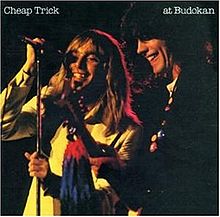 scuh-reeeming young Japanese girls. Lots of energy, and a couple fun tunes. In the second song, listen for when the singer says “CRYIN” and the response of “CRY, CRY, CRY”.
scuh-reeeming young Japanese girls. Lots of energy, and a couple fun tunes. In the second song, listen for when the singer says “CRYIN” and the response of “CRY, CRY, CRY”.
On the final day of the season, the local media wondered: would the ’71 Indians avoid an ignominious eighth straight loss? They had to break out of the 50s in wins, didn’t they?
Vince Colbert was the starter for the Tribe. On the hill for the Tigers was 25 game winner Mickey Lolich- the eventual second-place vote-getter for the A.L. Cy Young Award. He threw a league-leading 376 innings in '71, and recorded 308 strikeouts in an era when hitters cared about those.
In the bottom of the 1st inning of a 0-0 ballgame, Lolich encountered some early trouble. Ted Ford of the Indians singled to center. “Dirty” Kurt Bevacqua reached on an error by Brinkman. After a wild pitch, Ray Fosse sent a sacrifice fly to center that scored Ford. AFTER 1, 1-0 TRIBE.
In the bottom of the 3rd, Roy Foster and Fosse drew two-out walks. Graig Nettles singled up the middle to score Foster. AFTER 3, 2-1 TRIBE.
In the 4th, C Tim Hosley of the Tigers singled home Gates Brown, whom had opened the inning with a single of his own.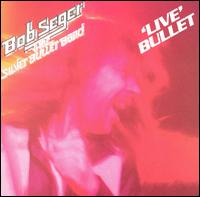
That was it. Both pitchers were on their game, and both went the distance. For Mickey Lolich, it was his 29th complete game. But the Tigers, winners of 91 games, went home for the winter, just like the Indians.
“Turn the Page”, from “Live Bullet” (1976) by Bob Seger and the Silver Bullet Band. Puts the studio version (which you seldom hear) to shame, with the haunting saxophone adding to the story about life on the road. This was the biggest hit on this live album. Some of the other cuts drag just a bit, but there’s plenty of stuff worth listening to. “Nutbush City Limits”, “Travelin’ Man”, and “Beautiful Loser” among them.
Only 2,596 paid to see the 1971 Indians finale. However, there would seem to have been over 100,000, based on the number of fans who come out of the woodwork these days and insist they were there. (Wait- that was either for this game, or the 1981 perfect game thrown by Lenny Barker. One of those two.)
We heard a suggestion from Neil Young at the top of this piece. Regrettably, that “Hawks and Doves” album feels like kind of a throwaway, in the context of that era’s “Rust Never Sleeps” and “Live Rust” – not to mention all the classic Neil stuff from the ten-plus years prior.
While we’re enjoying some live rock today, I wanted to tack on one more number. It’s “Comes a Time”, from the 1986 Farm Aid concerts (part of an ongoing benefit for financially strapped farmers). Backed by singer Nicolette Larson (during a time when it appears she was ‘in a good place’), Neil does a nice job on a favorite of mine. What I like as much as anything is that this is rare footage where he actually smiles and seems to be having fun. (He was smiling during The Band’s “The Last Waltz”, but he pretty much played the creepy drunk that night. If you get a chance to see that movie sometime (again?), watch Joni Mitchell avoiding him when they are on stage together, toward the end of the movie. That’s entertainment, right there.)
***Hey, follow me on Twitter! http://twitter.com/googleeph2 #thanks
Sources included baseball-reference.com; Wikipedia.